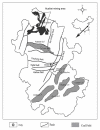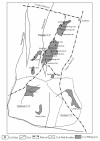Sequential solvent extraction for the modes of occurrence of selenium in coals of different ranks from the Huaibei Coalfield, China
- PMID: 18093341
- PMCID: PMC2242793
- DOI: 10.1186/1467-4866-8-14
Sequential solvent extraction for the modes of occurrence of selenium in coals of different ranks from the Huaibei Coalfield, China
Abstract
Forms of selenium in bituminous coal, anthracite, and cokeite (natural coke) from Huaibei Coalfield, Anhui, China, have been determined by sequential solvent extraction. The selenium content in bulk samples is 4.0, 2.4, and 2.0 microg/g in bituminous coal, anthracite, and cokeite, respectively. The six forms of selenium determined by six-step solvent extraction are water-leachable, ion-exchangeable, organic matter-associated, carbonate-associated, silicate-associated, and sulfide-associated. The predominant forms of selenium in bituminous coal are organic matter-associated (39.0%), sulfide-associated (21.1%), and silicate bound (31.8%); these three forms account for 92% of the total. The organic matter bound-selenium decrease dramatically from bituminous coal (39.0%) to anthracite (11.6%) and to cokeite (0%), indicating that organic matter bound selenium is converted to other forms during metamorphism of the coal, most likely sulfide-form. The sulfide-associated form increased remarkably from bituminous coal (21.1%) to anthracite (50.4%) and cokeite (54.5%), indicating the formation of selenium sulfide, possibly in pyrite during the transformation of bituminous coal to anthracite and cokeite. The silicate-associated selenium in bituminous coal (31.8%) is much higher than that in anthracite (16.4%) and cokeite (15.8%), indicating that silicate-associated selenium is partly converted to sulfide during metamorphism.
Figures
Similar articles
-
[Study on modes of occurrence of bromine in coals using sequential chemical extraction procedure].Huan Jing Ke Xue. 2011 Jul;32(7):2109-13. Huan Jing Ke Xue. 2011. PMID: 21922838 Chinese.
-
The distribution, occurrence and environmental effect of mercury in Chinese coals.Sci Total Environ. 2007 Oct 1;384(1-3):374-83. doi: 10.1016/j.scitotenv.2007.05.037. Epub 2007 Jun 27. Sci Total Environ. 2007. PMID: 17599392
-
Hydrogen storage potential of coals as a function of pressure, temperature, and rank.J Colloid Interface Sci. 2022 Aug 15;620:86-93. doi: 10.1016/j.jcis.2022.03.138. Epub 2022 Mar 31. J Colloid Interface Sci. 2022. PMID: 35413608
-
Arsenic in Chinese coals: distribution, modes of occurrence, and environmental effects.Sci Total Environ. 2011 Dec 15;412-413:1-13. doi: 10.1016/j.scitotenv.2011.10.026. Epub 2011 Nov 10. Sci Total Environ. 2011. PMID: 22078371 Review.
-
Geochemistry of tin (Sn) in Chinese coals.Environ Geochem Health. 2016 Feb;38(1):1-23. doi: 10.1007/s10653-015-9686-z. Epub 2015 Feb 17. Environ Geochem Health. 2016. PMID: 25686909 Review.
References
-
- Chen BH, Hong CJ, Kan HD. Exposures and health outcomes from outdoor air pollutants in China. Toxicology. 2004;198:291–300. - PubMed
-
- Florig HK. China's air pollution risks. Environmental Science Technology. 1997;31:274A–279A. - PubMed
-
- Ni B. New progress in high-precision and high resolution seismic exploration technology in coal industry of China. Acta Geological Sinica. 2000;74:311.
-
- Xu X, Chen C, Qi H. Development of coal combustion pollution control for SO2 and NOx in China. Fuel Processing Technology. 2000;62:153–160.
-
- Zhong Tang, Yang Wang. Efficient and environment friendly use of coal. Fuel Processing Technology. 2000;62:137–141.
LinkOut - more resources
Full Text Sources




